Fertilizer is a key ingredient in growing and maintaining a green, healthy lawn. Proper fertilization practices produce a dense, medium- to dark-green turf that resists pests and environmental stresses. In turfgrass, there is no simple criterion, such as yield, that exist as appropriate quantitative measure of turfgrass response to fertiliser. Quality is largely a subjective feature and depends largely on fertilisation rate and timing. Careless application techniques or excessive amounts of fertiliser applied at the wrong time can result in serious turf damage. Successful turf maintenance fertilization requires that you assess your turf ’s nutritional requirements, understand fertilizers, know how much to apply and when, and use proper application.
Unfortunately, most homeowners do not fertilize because they simply do not know which products to use, or how and when to apply them. When shopping for fertilizer, you’ll find three numbers printed on the label. These numbers represent the proportion of nitrogen, phosphorus, and potassium, respectively, which are the primary nutrients needed to feed your lawn. These numbers are referred to as fertiliser grade. For example, a 5-1-5 (33%) bag will have 15% nitrogen, 3% phosphate, and 15% potassium. The rest of the bag usually contains filler material that helps ensure an even application of the fertilizer. Knowing the fertiliser grade is important in determining how much fertiliser you need for your lawn.
The nutrient required the greatest in amounts by turfgrass is nitrogen. Potassium is usually ranked as the second most used and followed by phosphorus. The source of nitrogen in your fertiliser is important in determining your turf’s growth rate, density and colour. There are two categories of nitrogen fertilisers: Quick-release and Slow release. Quick release fertilisers are soluble in water and nitrogen become available immediately to the plant. They burn turf more easily than slow release fertilisers when insufficient water is applied. In contrast, slow release fertilisers typically release their nitrogen relatively over longer periods and allows for longer waiting period between application. With slow-release fertilizers, you can feed your lawn every three months when using quick-release fertilisers and every four (4) months when using slow-release fertilisers. Most homeowners are trying out organic care practices by using compost to fertilise lawns. The nitrogen compost supplies to the lawn becomes available to the roots slowly, which avoids nitrogen leaching. Compost does more than feeding the lawn; builds and feeds the soil. Compost consists of microorganisms, micronutrients and organic matter – items that nourish and foster a healthy underground environment in your soil. Compost may be spread thinly on your lawn in early Spring to fuel strong growth.
WHEN TO FERTILISE
New lawn: If you are starting a new lawn from seed, sod or plugs or you are doing bare lawn spot repair, high level phosphorus fertiliser is required. Apply 50 g/m2 of Superphosphate and 30g/m2 of 5:1:5 or 3:1:5 fertiliser. Unlike established lawns, new grass benefits from extra phosphorus, an essential plant nutrient that supports strong, deep roots. It is important to plant your grass at the right time.
Established lawn: To keep your existing lawn looking its best year-round, choose a fertilizer plan that meets its changing seasonal needs.
- Early Spring: Late August and September, temperatures warm and weed seeds start to germinate. This allows you to fertilise your lawn before it enters its peak growing phase.
- Late Spring: Between October and November, turf is actively growing.
- Summer: Between December and January, proper feeding helps strengthen lawns against heat and drought. Keep your lawn beautiful and resilient.
- Autumn: Between late February and March, grass slows down and prepares for the winter months. As a rule of thumb, allow six to eight weeks between fertilizing and your first expected frost. During this time of the year, Potassium is highly recommended as it improves turfgrass wear tolerance as well as survival during periods of cold, heat and drought stress. In addition, this allows early Spring green-up for warm season grasses.
MayFord® Seed suggests a fertiliser application rate of 30g/m2 for inorganic fertilisers 5:1:5 or 3:1:5. This is because under favourable growing conditions, a general rule is to apply no more than 5g N/m2 at a time. Please see an example below on how to calculate fertiliser requirement.
Calculating the fertiliser
Step 1: Convert the ratios into percentages – 5:1:5 (33%)
5 + 1 + 5 = 11 total ratio; 33% is total percentage of nutrients thus:

Step 2: Convert the N, P, K percentage into grams (g). A handful of granular fertiliser equates to 30g as suggested by MayFord Seed.
N = 15% x 30g = 4,5g
P = 3% x 30g = 0,9g
K = 15% x 30kg = 4,5g
As result, the suggested rate of MayFord Seed gives the recommended rate of nitrogen. Based on the percentage nutrient of the fertiliser, the amount of fertiliser required will differ.

